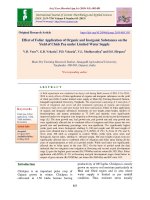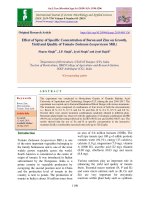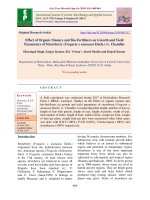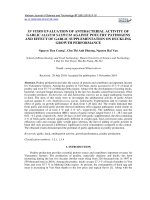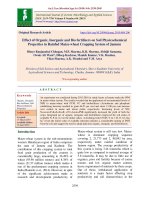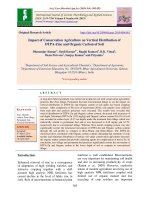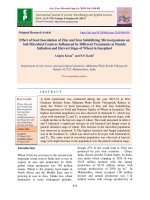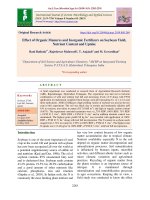Effect of peripartum organic zinc and copper supplementation on blood metabolic and hormonal profiling of primiparous buffaloes
Bạn đang xem bản rút gọn của tài liệu. Xem và tải ngay bản đầy đủ của tài liệu tại đây (271.42 KB, 11 trang )
Int.J.Curr.Microbiol.App.Sci (2019) 8(9): 2858-2868
International Journal of Current Microbiology and Applied Sciences
ISSN: 2319-7706 Volume 8 Number 09 (2019)
Journal homepage:
Original Research Article
/>
Effect of Peripartum Organic Zinc and Copper Supplementation on Blood
Metabolic and Hormonal Profiling of Primiparous Buffaloes
Arashdeep Kaur1*, Prahlad Singh1, Mrigank Honparkhe1, R. S. Grewal2,
Ajeet Kumar1, Ashwani Kumar Singh1, Navdeep Singh3,
Shahbaz Singh Dhindsa1 and Ankit Kumar Ahuja1
1
Department of Veterinary Gynaecology and Obstetrics, Guru Angad Dev Veterinary and
Animal Sciences University, Ludhiana, Punjab, India
2
Department of Animal Nutrition, Guru Angad Dev Veterinary and Animal Sciences
University, Ludhiana, Punjab, India
3
Directorate Livestock Farms, Guru Angad Dev Veterinary and Animal Sciences University,
Ludhiana, Punjab, India
*Corresponding author
ABSTRACT
Keywords
Trace Minerals,
Buffalo, Metabolic
profile, Hormonal
Levels
Article Info
Accepted:
24 August 2019
Available Online:
10 September 2019
This study evaluated effects of organic trace mineral supplementation on hormonal and
metabolic profile of primiparous buffaloes. Fourteen animals were randomly divided into
two groups control (n=7) and treatment (n=7; Copper@225mg, per animal
per day). Treatment group was supplemented with organic copper at the rate of 225mg and
Zinc at rate1.0gm per animal per day respectively, in addition to normal feeding, 60 days
before the expected date of calving till the date of artificial insemination. A significant
(p<0.05) decrease in the serumnon-esterified fatty acid (NEFA) levels (µmol/l) was
observed in supplemented (388.88 ± 3.73 to 334.40 ± 2.86 µmol/l) than control group
(405.27 ± 2.63 to 352.92 ± 5.45 µmol/l) buffaloes. There was significant difference
(p<0.05) in total protein (g/dl) values between treatment (6.90 ± 0.06 to 7.35 ± 0.05 g/dl)
and control group (6.22 ± 0.20 to 6.35 ± 0.22 g/dl). Total protein (g/dl) increased after
parturition in treatment group, while in control group the concentration of total protein did
not change significantly after parturition. No significant difference was observed in
progesterone (0.33 ± 0.01 to 1.83 ± 0.06ng/ml vs. 0.26 ± 0.01 to 1.29 ± 0.08 ng/ml) and
estradiol (22.67 ± 0.42 to 140.82 ± 0.51pg/ml vs. 21.04 ± 0.16 to 145.23 ± 0.39 pg/ml)
concentration in supplemented and control group, respectively. We concluded that
supplementation of organic trace mineral significantly improved the total protein and nonesterified fatty acid levels in blood thus helps in proper mobilisation and utilisation of
body reserves but it did not affect the blood hormonal profile significantly.
Introduction
World buffalo population is approximately
170 million with 97 percent in Asia (FAO
2004). India is possessing 56 percent of world
buffalo population. The production potential
of buffaloes is constrained by its low
reproductive efficiency due to higher age of
2858
Int.J.Curr.Microbiol.App.Sci (2019) 8(9): 2858-2868
puberty, poor conception rates, longer service
period and calving interval. The success of the
dairy buffalo economy lies in optimal
reproductive cycle of each individual buffalo
in the herd within normal physiological range
(Dhaliwal 2005). Any deviation in the
breeding cycle results in a progressive
economic loss due to prolonged dry period
and reduced calvings and lactations during the
life span of the animal (Singh et al.,
2006).Minerals have basic key role in
maintenance of metabolism and studies on
their nutritional requirements in the body led
to the classification of these minerals as macro
and micro minerals. Adequate mineral intake
and absorption is required for a variety of
metabolic functions including immune
response
to
pathogenic
challenge,
reproduction and growth (Garg et al., 2009).
Copper is mainly stored in the liver and is an
enzyme component of essential metabolic
processes. As an enzyme activator, it provides
strong bones and joints and is heavily
involved in the utilization of iron and thus the
synthesis of hemoglobin. Through the
promotion of superoxide dismutase, which
deactivates free oxygen radicals, copper is
also involved in cell protection and healthy
immune system. Copper as a component of
enzymes like peptidylglycine α-amidating
monoxygenase (PAM) and dopamine βmonoxygenase plays an important role in the
activation of gonadotropin releasing enzyme
(Michaluk and Kochman 2007). Cu appeared
to be the cause of delayed puberty (possibly
due to depressed basal LH release, affecting
follicular estradiol production), reduced
conception rate, and failure to ovulate
(Phillippo et al., 1987). Copper interact with
granulosa cells for production of estrogen.
Altered plasmatic level of Cu confers changes
in pattern and level of steroidal hormone
synthesis leading to decline in overall fertility
and altered reproductive behaviour in females
eg. nymphomania in ewe (Hidiroglou 1979).
Zinc is the second most common trace
element. It acts as an activator and a
component of more than 300 enzymes and
hormones. Zinc plays an important role in
metabolism, protein biosynthesis and the
regulation of gene activity. Due to its crucial
function in defense enzymes (copper-zinc
superoxide dismutase), zinc deficiency
reduces resistance. In dairy animals zinc
deficiency signs can be seen as bad hoof and
horn quality, reduced fertility and poor udder
health. Zinc is considered to be vital for
proper
sexual
maturity,
reproductive
efficiency, regulation and onset of estrus
(Green et al., 1998). GnRH secretion in the
body is regulated by plasma zinc levels which
is essential for secretion and maintaining the
activity of FSH and LH (Das et al., 2009).
During periods of zinc deficiency due to
alterations in synthesis and secretion of these
hormones leads to arrest of ovulation, erratic
estrus cycles and abnormal reproductive
performance of animal (Kaswan and Bedwal
1995). Zinc takes part in maintenance of
epithelial integrity of uterine lining in cattle
for implantation of embryos and its
insufficient levels is found to be associated
with abortion, fetal mummification, lower
birth weights and prolonged labor (Kumar et
al., 2011). Stanton et al., (2000) reported that
cows receiving organic trace minerals
exhibited higher pregnancy rates to AI than
those receiving inorganic trace minerals. Bisla
et al., (2006) and Kumar (2008) recorded
more number of animals exhibited estrus and
improved in the conception rate in postpartum
anoestrus
buffaloes
with
mineral
supplementation. Jyoti Sharma et al., (2009)
observed estrus in 66.67 per cent of the cattle
fed with concentrate feed containing
dicalcium phosphate, copper sulphate and
magnesium sulphate. Transition period is an
important and vulnerable period encountered
by dairy cow that extends from three weeks
before and after calving (Curtis et al., 1985,
2859
Int.J.Curr.Microbiol.App.Sci (2019) 8(9): 2858-2868
Grummer 1995). Dairy cow experience about
one-third decrease in feed intake during the
last three weeks prior to calving, with
significant reduction observed in the final
week before parturition (Hayirli et al., 2002).
This is mainly due to increase in concentration
of circulating estrogen and less capacity for
rumen to expand because of increased foetus
size. After calving, the cow which was already
consuming low proportion of dietary energy,
mobilizes fat (NEFA) from adipose tissues as
a source of energy for maintenance of body
functions and to support milk production
resulting into negative energy balance (Moore
et al., 2005). Circulating concentration of
blood metabolites like NEFA and BHBA have
negative effect on post-partum fertility leading
to anoestrous, low conception rates, long
calving interval with decreased survivability
of embryo in subsequent pregnancies (Staples
et al., 1990).
Materials and Methods
Location
All procedures were approved by the
Institutional Animal Ethics Committee (IAEC:
GADVASU/2018/IAEC/45/01). Study was
conducted on 14 primiparous buffaloes being
reared at Directorate Livestock Farm, Guru
Angad Dev Veterinary and Animal Sciences
University, Punjab, India (30.9°N,75.85°E and
256 m above sea level), where the climate is
humid sub-tropical with defined seasons.
Selection of Animals
All the buffaloes selected were in first parity
having a body condition score of ≥3.
Buffaloes were selected 60 days before
calving and maintained until artificial
insemination. All these buffaloes were
maintained under general managemental
practices as followed for pregnant animals in
the herd at the Directorate Livestock Farm,
GADVASU, Ludhiana. The feed and water
were available ad lib to these animals. At the
beginning of the experiment the average age
and body weight of buffaloes in control group
was783.75±40.51 days and548.33±32.91 kg
and in treatment group was 716.67±42.82 days
and 562.0±38.65 kg. Animals were housed in
semi conventional housing system during the
months of January 2018 to May 2019.
Animals were divided into two groups control
(n=7) and treatment (n=7).
Feeding
The nutrient requirements of the animals were
mostly met with ad lib green fodder and
measured amount of concentrate. The green
fodders grown in the institute farm, were
supplied according to the seasonal availability.
The concentrate was fed at the rate of 2.5
kg/day per animal for body maintenance to
heifers. For pregnant animals 1kg/day/animal
(upto seven months) and 2 kg/day/animal
during advanced pregnancy (last 90 days).
Milking buffaloes were given additional
concentrate at the rate of 1.0 kg for every 1.5
kg milk production, above 5.0 kg milk yield.
The concentrate to the milking animals was
fed in divided allowances during milking. The
diets provided for pre and post-calving cows,
as well as the chemical analyses are shown in
Table 1 and 2. Control group (n=7) was fed as
per the standards followed at Dairy Farm,
Guru Angad Dev Veterinary and Animal
Sciences University, Ludhiana. Treatment
group (n=7) was supplemented with organic
copper and zinc supplementation in addition to
normal
feeding,
Copper@225mg,
per animal per day, 60 days
before the expected date of calving till the date
of artificial insemination.
Blood Sampling
All buffaloes were subjected to blood
sampling (10 ml), through jugular vein-
2860
Int.J.Curr.Microbiol.App.Sci (2019) 8(9): 2858-2868
puncture at weekly interval after parturition
until artificial insemination in both group I
and II. Blood samples were collected into
spinwin conical tubes (Tarsons Products Pvt.
Ltd. Maharashtra, India) which were
immediately placed in the icebox and
transferred to the laboratory. Serum was
harvested by centrifugation (3000 rpm, 15
minutes) and stored at -20oC until the
hormonal and metabolic profiling.
Hormonal and metabolic profiling
Serum progesterone and estradiol estimation
was done using a solid phase enzyme
immunoassay kits. ELISA kits used for P4 and
E2 were manufactured by XEMA Co. Ltd
(Moscow, Russia) with catalog number K207
and K208 respectively. The sensitivity of the
progesterone and estradiol assay was 0.6
ng/ml and 62.4 pg/ml.
For estimation of serum NEFA sandwich
ELISA KIT manufactured by Bioassay
Technology Laboratory (Shanghai, China)
with catalog number E0021Bo was used. Total
protein estimation was done using the
VITROS chemistry products TP Slides (Ortho
Clinical Diagnostics, Mumbai, India) and the
VITROS Chemistry Products DT Calibrator
Kit on VITROS DT 60/DT60 2 Chemistry
Systems (Ortho- Clinical Diagnostics, Johnson
and Johnson, SA).
Statistical analyses
Data generated by ultrasound examination and
hormone assay were subjected to statistical
analysis using IBM SPSS Statistical Version
23 (SPSS 23.0 for windows; SPSS, Chicago,
IL, USA). To compare the effect of treatment
on serum P4 concentration (ng/ml), serum E2
concentration (pg/ml), TP value (g/dl) and
NEFA concentration (µmol/l)over days within
the group, data were analyzed using “One way
ANOVA”. The whole of the analyzed data is
presented as Mean ± SEM. A probability level
of (p < 0.05) was considered significant.
Results and Discussion
Blood metabolic profile in postpartum
primiparous buffaloes fed trace mineral
supplement
Mean serum NEFA values obtained across
different days in treatment and control group
are presented in Table 3. Concentration of
NEFA were highest at the day of calving
(388.88±3.73 and 405.27±2.63 µmol/l) and
lowest on day 56 postpartum (334.40±2.86
and 352.92±5.45 µmol/l) in treatment and
control groups respectively. A significant
(p<0.05) decrease in the serum NEFA levels
(µmol/l) was observed in supplemented than
control group buffaloes.
Concentration of NEFA peaked on the day of
calving and then decreased on day 7
postpartum in both the groups but decrease
was more rapid in treatment group as
compared to control group (Figure 1), and is
in affirmation of studies by Vazquez-Anon M
et al., (1994) and Grum DE et al., (1996).
Accorsi et al., reported higher NEFA levels
until first 10 days after calving. Yang WZ et
al., (1996) reported that control buffaloes had
higher NEFA concentrations when compared
to buffalo receiving chromium, suggesting
greater mobilization of body reserves.
Nonesterified fatty acids and BHBA are
considered as markers of negative energy
balance during the transition period (Ospina et
al., 2010 a,b, Chapinal et al., 2011, McArt et
al., 2012 b). Elevation of NEFA or BHBA
concentrations during pre- and postpartum
periods have been associated with negative
downstream outcomes in individual animals,
such as decreased milk production (Duffield et
al., 2009, Ospina et al., 2010b, McArt et al.,
2012b), decreased reproductive function
(Ospina et al., 2010b, McArt et al., 2012b,
2861
Int.J.Curr.Microbiol.App.Sci (2019) 8(9): 2858-2868
Garverick et al., 2013), increased risk of
health disorders (LeBlanc et al., 2005, McArt
et al., 2012a), and increased risk of removal
from the herd (Ospina et al., 2010a, Roberts et
al., 2012, McArt et al., 2012b), as well as on a
herd level basis (Ospina et al., 2010c).
Findings are suggestive of better feed
utilization and assimilation of available energy
in supplemented group, treated animals
maintained better energy balance and
reproductive performance than the control
animals. Serum total protein levels across
different days in treatment and control groups
are presented in Table 3.
Fig.1 Serum NEFA (µmol/l) and total protein (g/dl) comparison between
treatment and control groups
NEFA (T): NEFA in treatment group; NEFA (C): NEFA in control group; TP (T): Total protein in control group; TP
(C) Total protein in treatment group
Fig.2 Serum progesterone (ng/ml) and estradiol (pg/ml) comparison between treatment and
control groups
E(C): Estradiol in control group; E (T): Estradiol in treatment group; P (T): Progesterone in control group; P (C)
Progesterone in treatment group
2862
Int.J.Curr.Microbiol.App.Sci (2019) 8(9): 2858-2868
Table.1 Ingredient composition of concentrate mixtures (%)
Ingredient
Maize
Soybean
meal
Mustard
cake
Concentrat
e Mixture
(%)
40.00
10.00
20.00
Full
fat
soya
2.00
Guar
Korma
3.00
Cotton
seed
meal
4.00
Deoiled
Rice
bran
16.7
Mineral
mixture
Calcite
powder
Salt
Yeasac
Toxin
binder
Vitamin
mix
2.00
0.50
1.50
0.10
0.10
0.10
Table.2 Composition of Mineral mixtures (%)
Type of
Di
Limestone Magnesium Magnesium Copper
Iron
Manganese Potassium Cobalt
Zinc
mineral Calcium
Powder
Oxide
Sulphate
Sulphate Sulphate Sulphate
Iodate
Sulphate Sulphate
source Phosphate
59.77
21.98
07.83
04.98
0.427
01.50
0.427
0.050
0.050
02.99
Mineral
Mixture
(%)
2863
Int.J.Curr.Microbiol.App.Sci (2019) 8(9): 2858-2868
Table.3 Blood NEFA and TP levels (Mean ± SEM) in postpartum primiparous buffaloes fed
trace mineral supplement
Days
0
7
14
21
28
35
42
49
56
*NEFA (µmol/l)
Treatment (n=7)
Control (n=7)
388.88 ± 3.73
405.27 ± 2.63
355.61 ± 3.97
367.34 ± 2.29
349.27 ± 4.11
365.63 ± 3.14
345.65 ± 4.35
363.82 ± 2.60
343.24 ± 4.30
359.70 ± 3.88
340.93 ± 4.38
357.86 ± 4.89
338.07 ± 3.56
356.59 ± 4.85
335.35 ± 3.49
355.70 ± 6.13
334.40 ± 2.86
352.92 ± 5.45
*TP (g/dl)
Treatment (n=7)
Control (n=7)
6.90 ± 0.06
6.25 ± 0.23
6.97 ±0.04
6.30 ± 0.21
6.97 ± 0.05
6.28 ± 0.15
7.12 ± 0.05
6.35 ± 0.22
7.17 ± 0.05
6.27 ± 0.20
7.20 ± 0.11
6.31 ± 0.17
7.24 ± 0.11
6.22 ± 0.20
7.25 ± 0.07
6.24 ± 0.14
7.35 ± 0.05
6.31 ± 0.16
*Significant difference at p<0.05 level
Table.4 Blood progesterone and estradiol levels (Mean ± SEM) in postpartum primiparous
buffaloes fed trace mineral supplement
Days
0
7
14
21
28
35
42
49
56
Progesterone (ng/ml)
Treatment (n=7)
Control (n=7)
0.56 ± 0.009
0.48 ± 0.02
0.33 ± 0.01
0.26 ± 0.01
0.50 ± 0.07
0.34 ± 0.01
0.63 ± 0.01
0.50 ± 0.006
0.71 ± 0.009
0.70 ± 0.01
0.83 ± 0.02
1.16 ± 0.07
1.22 ± 0.08
1.44 ± 0.04
1.51 ± 0.04
1.19 ± 0.02
1.83 ± 0.06
1.29 ± 0.08
Total protein in treatment group was highest
(7.35±0.05 g/dl) and lowest (6.90±0.06 g/dl)
on day 56 and 0 postpartum, respectively.
While in control group the concentration was
highest (6.35±0.22 g/dl) and lowest
(6.22±0.20 g/dl) on day 21 and 42
postpartum, respectively.
Total protein increased after parturition in
treatment group, while in control group the
concentration of total protein did not change
significantly after parturition. There was
significant difference (p<0.05) in total protein
Estradiol (pg/ml)
Treatment (n=7)
Control (n=7)
140.82 ± 0.51
145.23 ± 0.39
45.17 ± 0.30
45.70 ± 0.17
22.67 ± 0.42
21.04 ± 0.16
25.25 ± 0.27
24.10 ± 0.40
26.32 ± 0.42
22.39 ± 0.46
24.98 ± 0.28
24.55 ± 0.27
28.52 ± 0.33
24.77 ± 0.19
27.33 ± 0.33
25.66 ± 0.27
28.16 ± 0.34
26.86 ± 0.47
values between treatment and control group
(Figure 1).
Results obtained were in affirmation with
Nagalakshmi et al., (2016), wherein,
increased concentration of total protein was
observed in animals supplemented with
organic Zn compared to inorganic Zn.
Shakweer et al., (2010) also observed
increase in total protein concentration due to
zinc supplementation. Mousa and EL-Sheikh
(2004) revealed that addition of 80 and 120
mg zinc sulfate improved total protein in
2864
Int.J.Curr.Microbiol.App.Sci (2019) 8(9): 2858-2868
blood serum of lactating buffaloes. Similar
findings, by Shakweer et al., (2005),
Shakweer and EL-Nahas (2005) and
Shakweer et al., (2006) found increased
concentration of total protein with different
level of zinc methionine supplementation.
As the calving approaches, negative energy
balance and catabolism of body tissue
increases which leads to degradation of the
body fat and the body protein. DMI decrease
is a prelude to decreased protein availability
in the body leading to blood protein level
reduction as ammonia is not available for the
synthesis of amino acid. Strang et al., (1998)
reported that triglyceride loaded hepatocytes
were less sensitive to the hormonal
stimulation for albumin and protein synthesis
than normal hepatocytes. Increased level of
NEFA in the control group may be the reason
of decreased level of total protein in the
control group.
Hormonal
levels
in
postpartum
primiparous buffaloes fed trace mineral
supplement
Serum progesterone values obtained across
different days in the treatment and control
groups are presented in Table 4. Higher
progesterone concentration was 1.83±0.06
ng/ml on day 56 and 0.33±0.01 ng/ml on day
7 postpartum in the treatment group. In
control group animals higher concentration
was 1.44±0.04 and 0.26±0.01 ng/ml on day
42 and 7 postpartum, respectively.
Progesterone concentrations were at baseline
level within 24 hours from calving with a
rising trend from day 7 postpartum in both
treatment and control groups. Trace mineral
supplemented buffaloes had slightly higher
levels on all days except on day 35 and 42
postpartum wherein the control group had
slightly higher values of progesterone (Figure
2). Serum progesterone values in this study
corroborated well with the earlier reports in
buffaloes (Prakash and Madan 1986). Similar
results were observed by Singh et al., (2012).
Dhami et al., (2015) reported similar results
in cattle. Kalasariya et al., (2017) observed
that mineral supplementation had no
significant
effect
on
progesterone
concentration and was true for present work.
Mean serum estradiol values obtained across
different days of the study in treatment and
control groups are presented in Table 4.
Estradiol was highest 140.82±0.51 pg/ml on
day of calving and lowest 22.67±0.42 pg/ml
on day 14 postpartum in treatment group
while in control group the concentration was
highest 145.23±0.39 pg/ml and lowest
21.04±0.16 pg/ml on day 0 and 14
postpartum, respectively. Estradiol values
peaked on the day of parturition and showed a
decreasing trend thereafter in both treatment
and control group as depicted in Figure 4.
Estradiol showed a rising trend from day 7
postpartum in both the groups.
Trace mineral supplemented group had
slightly higher concentration of Estradiol on
all days except on day 0 and 7 postpartum
wherein control group had slightly higher
values of Estradiol (Figure 2). Values
obtained were similar to the findings of
Kalasariya et al., (2017) and also agreed to
the trend of postpartum Estradiol profile
reported by Singh et al., (2012). Arya and
Madan (2001) reported similar Estradiol
values postpartum. Dhami et al., (2015)
observed similar results in cattle.
Supplementation of copper at the rate of
225mg and zinc at the rate of 1.0gm per
animal per day significantly improves the
total protein and non-esterified fatty acid
levels in blood thus helps in proper
mobilisation and utilisation of body reserves.
However it did not affect the blood hormonal
profile significantly but still there exist some
numerical difference among their values from
control group. Hence, chelated mineral
2865
Int.J.Curr.Microbiol.App.Sci (2019) 8(9): 2858-2868
supplementation during pre and post-partum
period is better option to improve the
reproductive performance in primiparous
buffaloes.
References
Accorsi PA, Camberoni A, Isani G, Viggiani R,
Monari M, De Ambrogi M, Munno A,
Tamanini C, Seren E. 2005. Leptin does
not seem to influence glucose uptake by
bovine mammary explants. J Physiol
Pharmacol 56: 689–698
Arya J S and Madan M L. 2001. Post-partum
reproductive cyclicity based on ovarian
steroids in suckled and weaned
buffaloes. Buffalo Journal. 17(3): 361370.
Bisla RS, Singh U, Chaudhri SS and Dahiya
AS.
2006.
Effect
of
dietary
supplementation with mineral mixture
and anti helmintic treatment on
production and fertility response in rural
anestrus buffaloes. Haryana Veterinarian
45: 82-84.
Chapinal N, Carson M E, Duffield T F, Capel
M, Godden S, Overton M W, Santos J E
P and LeBlanc S J. 2011. The association
of serum metabolites with clinical disease
during the transition period. J. Dairy Sci.
94: 4897–4903.
Curtis CR, Erb HN, Sniffen CJ, Smith RD and
Kronfeld DS. 1985. Path analysis of dry
period nutrition, postpartum metabolic
and reproductive disorders, and mastitis
in Holstein cows. Journal of Dairy
Science 68: 2347-2360.
Das J M, Dutta P, Deka K C, Biswas R K,
Sarmah B C and Dhali A. 2009.
Comparative study on serum macro and
micro mineral profiles during oestrus in
repeat breeding crossbred cattle with
impaired and normal ovulation. Livestock
Research for rural development. 21: 5
Dhaliwal GS. 2005. Managing dairy herds for
optimal reproductive efficiency. Recent
concepts in physio-pathology of animal
reproduction, 1-9. In Centre of Advanced
studies in Veterinary Gynaecology and
Reproduction.
Punjab
Agricultural
University, Ludhiana, India.
Dhami A J, Theodore V K, Panchal M T,
Hadiya K K, Lunagariya P M and
Sarvaiya NP. 2017. Effect of peripartum
nutritional
supplementation
on
postpartum
fertility
and
blood
biochemical and steroid hormone profile
in crossbred cows. Indian Journal of
Animal Research, 51(5).
Duffield T F, Lissemore K D, McBride B W
and Leslie K E. 2009. Impact of
hyperketonemia in early lactation dairy
cows on health and production. J. Dairy
Sci. 92: 571–580.
Garg M R, Bhanderi B M and Sherasia P L.
2009. Macro and micro-mineral status of
feeds and fodders fed to buffaloes in
semi-arid zone of Rajasthan. Animal
Nutrition and Feed Technology. 9(2):
209-220
Garverick H A, Harris M N, Vogel-Bluel R,
Sampson J D, Bader J, Lamberson W R,
Spain J N, Lucy M C and Youngquist R
S. 2013. Concentrations of nonesterified
fatty acids and glucose in blood of
periparturient dairy cows are indicative of
pregnancy success at first insemination. J.
Dairy Sci. 96: 181–188.
Green l W, Johnson A B, Paterson J and
Ansotegui R. 1998. Feedstuffs. 70: 58
Grum D E, Drackley J K, Younker R S, La
Count D W and Veenhuizen JJ. 1996
Nutrition during the dry period and
hepatic lipid metabolism of periparturient
dairy cows. J Dairy Sci 79: 1850–1864
Grummer RR. 1995. Impact of changes in
organic nutrient metabolism on feeding
the transition dairy cow. Journal of
Animal Science 73: 2820–2833.
Hayirli A, Grummer RR, Nordheim E V, and
Crump P M. 2002. Animal and dietary
factors affecting feed intake during the
prefresh transition period in Holsteins.
Journal of Dairy Science 85: 3430-3443.
Jyoti Sharma, Anil Kumar, Tiwari D P, Mondal
B C. 2009. Effect of dietary
supplementation of calcium, copper and
2866
Int.J.Curr.Microbiol.App.Sci (2019) 8(9): 2858-2868
manganese on production performance of
dairy cattle in Pithoragarh district of
Uttarakhand. Indian Journal of Animal
Sciences. 79: 686-691
Kalasariya R M, Dhami A J, Hadiya K K,
Borkhatariya D N and Patel J A. 2017.
Effect
of
peripartum
nutritional
management on plasma profile of steroid
hormones, metabolites, and postpartum
fertility
in
buffaloes. Veterinary
world. 10(3): 302.
Kaswan S and Bedwal R S. 1995. Light and
electron. Microscopic changes in the
ovary of zinc deficient BALB/c mice.
Indian J. Exp. Biol. 33: 469
Kumar RK. 2008. Reproductive performance of
dairy buffaloes by supplementing fortified
mineral mixture in daily ration. Asian
Journal of Animal Science. 3: 8-9.
Kumar S, Pandey A K, Razzaque W A A and
Dwivedi D K. 2011. Importance of micro
minerals in reproductive performance of
livestock. Vet. World. 4(5): 230-233
Leblance S J, Leslie K E and Duffieid T D.
2005. Metabolic predictors of displaced
abomasum in dairy cattle. J. Dairy Sci.
88: 159-170.
McArt J A A, Nydam D V and Oetzel G R.
2012a. A field trial on the effect of
propylene glycol on displaced abomasum,
removal from herd, and reproduction in
fresh cows diagnosed with subclinical
ketosis. J. Dairy Sci. 95: 2505–2512.
McArt J A A, Nydam D V and Oetzel G R.
2012b. Epidemiology of subclinical
ketosis in early lactation dairy cattle. J.
Dairy Sci. 95: 5056–5066.
Michaluk A and Kochman K. 2007.
Involvement of copper in female
reproduction. J.Repro. Biol. 7(3): 193-205
Moore CE, Kay JK, VanBaale MJ, and
Baumgard LH. 2005. Calculating and
improving energy balance during times of
nutrient limitations. Proc. Southwest
Nutr. Conf. 173-185.
Mousa Kh M M and S M E L-Sheikh. 2004.
Effect of different levels of zinc
supplementation on utilization of nonprotein nitrogen for lactating buffaloes. J.
Agric. Sci. Mansoura Univ., 29(6): 30633073.
Nagalakshmi D, Rao K S, Kumari G A, Sridhar
K and Satyanarayana M. 2016.
Comparative evaluation of organic zinc
supplementation as proteinate with
inorganic zinc in buffalo heifers on health
and immunity. Indian J. Anim. Sci. 86(3):
322-328.
Ospina P A, Nydam D V, Stokol T and Overton
T R. 2010a. Evaluation of nonesterified
fatty acids and beta-hydroxybutyrate in
transition dairy cattle in the northeastern
United States: Critical thresholds for
prediction of clinical diseases. J. Dairy
Sci. 93: 546–554.
Ospina P A, Nydam D V, Stokol T and Overton
T R. 2010b. Associations of elevated
nonesterified fatty acids and betahydroxybutyrate concentrations with
early lactation reproductive performance
and milk production in transition dairy
cattle in the northeastern United States. J.
Dairy Sci. 93: 1596–1603.
Ospina P A, Nydam D V, Stokol T and Overton
T R. 2010c. Association between the
proportion of sampled transition cows
with increased nonesterified fatty acids
and beta-hydroxybutyrate and disease
incidence, pregnancy rate, and milk
production at the herd level. J. Dairy Sci.
93: 3595–3601.
Phillippo M, Humphries W R and Atkinson T.
1987. The effect of dietary molybdenum
and iron on copper status, puberty,
fertility and oestrous cycles in cattle. J.
Agric. Sci. 109: 321-326
Prakash B S and Madan M L. 1986. Peripheral
plasma oestradiol-17β, progesterone and
cortisol in buffaloes induced to calve with
dexamethasone and vetoestrol. Animal
Reproduction Science. 11: 111-122.
Roberts T, Chapinal N, LeBlanc S J, Kelton D
F, Dubuc J and Duffield T F. 2012.
Metabolic parameters in transition cows
as indicators for early-lactation culling
risk. J. Dairy Sci. 95: 3057– 3063.
Shakweer I M E and EL-Nahas H M. 2005.
Productive performance of suckling
2867
Int.J.Curr.Microbiol.App.Sci (2019) 8(9): 2858-2868
calves fed diets supplemented with zinc
methionine. J. Agric. Sci. Mansoura Univ.
30(6): 3037-3046.
Shakweer I M E, EL-Mekass A A M and ELNahas H M. 2005. Effect of different
levels of supplemented organic zinc
source on performance of Friesian dairy
cows. J. Agric. Sci. Mansoura Univ.
30(6): 3025-3035
Shakweer I M E, EL-Mekass A A M and ELNahas H M. 2006. Effect of supplemental
zinc methionine concentrations on
digestibility, feed efficiency and some
ruminal and blood parameters and
performance of Friesian calves. J. Agric.
Sci. Mansoura Univ. 31(8): 4935-4935.
Shakweer I M E, El-Mekass A A M and ElNahas H M. 2010. Effect of two different
sources of zinc supplementation on
productive performance of Friesian dairy
cows. Egyptian J. Anim. Prod. 47(1), pp.
11-22.
Singh AP, Shah RS, Singh RB, Akhtar MH,
Roy GP, Singh C and V Kunj. 2006.
Response of mineral mixture, Prajana and
GnRH on serum biochemical constituents
and conception rate in anoestrus
buffaloes. Indian Journal of Animal
Reproduction 27(1): 51-54.
Singh S P, Mehla R K and Singh M. 2012.
Plasma hormones, metabolites, milk
production, and cholesterol levels in
Murrah buffaloes fed with Asparagus
racemosus in transition and postpartum
period. Tropical animal health and
production. 44(8): 1827-1832.
Stanton TL, Whittier JC, Geary TW,
Kimberling CV and Johnson AB. 2000.
Effects of trace mineral supplementation
on cow-calf performance, reproduction,
and immune function. Prof. Animal
Science 16: 121–127.
Staples CR, Thatcher WW, and Clark JH. 1990.
Relationship between ovarian activity and
energy status during the early postpartum
period of high producing dairy cows.
Journal of Dairy Science 73: 938-947
Strang B D, Bertics S J, Grummer R R and
Armentano L E. 1998. Relationship of
triglycerides accumulation to insulin
clearance and hormonal responsiveness in
bovine hepatocytes. J. Dairy Sci. 81:
740747
Vazquez-Anon M, Bertics S, Luck M,
Grummer R, Pinheiro J. 1994. Peripartum
liver triglyceride and plasma metabolites
in dairy cows. J Dairy Sci 77: 1521–1528
Yang WZ, Mowat DN, Subiyatno A, Liptrap
RM. 1996. Effects of chromium
supplementation on early lactation
performance of Holstein cows. Can J
Anim Sci 76: 221–230
How to cite this article:
Arashdeep Kaur, Prahlad Singh, Mrigank Honparkhe, R. S. Grewal, Ajeet Kumar, Ashwani
Kumar Singh, Navdeep Singh, Shahbaz Singh Dhindsa and Ankit Kumar Ahuja. 2019. Effect
of Peripartum Organic Zinc and Copper Supplementation on Blood Metabolic and Hormonal
Profiling of Primiparous Buffaloes. Int.J.Curr.Microbiol.App.Sci. 8(09): 2858-2868.
doi: />
2868
